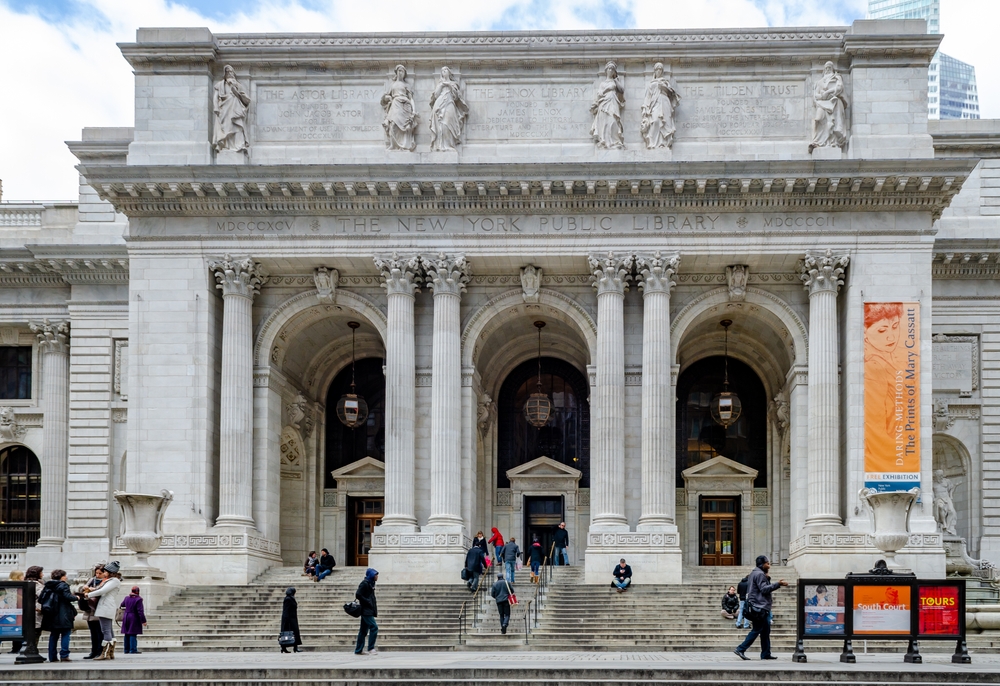It is said that deer used to run here long ago. It was a wild and unspoiled place, inhabited only by the indigenous people who farmed the land and hunted in the thick and extensive forests. It is hard to imagine that only 500 years ago such a bucolic world existed just outside the doors from where I sit now in the New York Public Library.
500 years seems scant compared to the sense of eternity conveyed by these towering columns supporting soaring ceilings decorated with frescoed, azure and infintensive skies. Like a Roman temple, it is a structure that according to the contemporary imagination seems to have always existed, but the reality is that it was built just over 100 years ago by architects John Merven Carrère and Thomas Hastings. An excellent example of the American interpretation of the beaux-arts style, in its style the New York Public Library starts from a French neoclassical base and blends Renaissance and Baroque influences. The outcome is a place that conveys a sense of solidity, permanence, and security.
I look around me at the decorative elements adorning the reading room and note the various artistic currents from which they were taken: Etruscan palms, Greek and Roman columns, grotesque motifs. Thousands of years of history repurposed in a Midtown Manhattan room in 1911, even before the United States of America celebrated its 150-year history.
I like to think that the choices of Carrère and Hastings and especially their benefactors-including, Andrew Carnegie-were not simply motivated by the artistic trends of the period, but that there was also a philosophical choice behind them. Built primarily to consolidate Astor’s and Lenox’s libraries, I would be forgiven for thinking that the New York Public Library served as a strong symbol not so much of what America was at that time in history, but what America could become: in short, the image of a collective dream. 100 years later, that dream has become a reality.
If in its thousands of years of History, Italy has developed a refined artistic language to communicate through figurative symbols and allegories, in its few centuries of history, the United States has done a similar, if accelerated (but no less valid) job. In those 248 years, Americans have perfected the art of dreaming: that ability to find motivation not in what has been, but in what could be. Founding Fathers dreamed of the future of a free New World freed from the powers of the British Crown. Endless waves of immigrants from all over the world dreamed of a better future in this country; with hard work and an iron faith in their own possibilities, many of them succeeded in achieving it. The New York Public Library itself, with its twentieth-century depiction of antiquity, manifests the implicit dream of its patrons: that the United States, too, could achieve the greatness of Ancient Rome. By dint of their belief, Americans have succeeded in turning this dream into reality.
Of course, it could be said that America has done a unique thing, facilitated by a new beginning in a new frontier of the world. In comparison, Italy for example, a child of its multi-thousand-year history, and with the weight of its years upon it, could never afford this advantage. There are problems of which it is as difficult to pinpoint the beginning as it is to imagine an end. It is too divided a country. And then there are the Italians: corrupt, poorly disciplined, allergic to work. So you might say, but you would be wrong.
In recent years, working in the Italian arts and crafts sector, I have had the pleasure of meeting many people who, despite their distant origins from America and its dream art, share its same spirit. Their influences will surely differ, but it is the confidence they give to their dreams that, similar to the Founding Fathers, the millions of immigrants who made it in America, and Andrew Carnegie and his architects himself, lights the way for them to create something great.
These are the people who, thanks to their unusual perspective, rather than accepting Italy as it has always been-its problems included-are working daily to create the Italy it could be: a dynamic and living place that, rather than giving in to the weight of its years, draws inspiration from them to imagine, and create, a different future. They are, or at least should be, an example to us all.
The article The American Dream comes from TheNewyorker.

